The electronic ink screen technology is widely known for its e-book readers, and has since attracted attention from mobile phones and wearable devices. What is the principle of this display technology? What are the advantages and disadvantages of common display technologies? This article will come together.
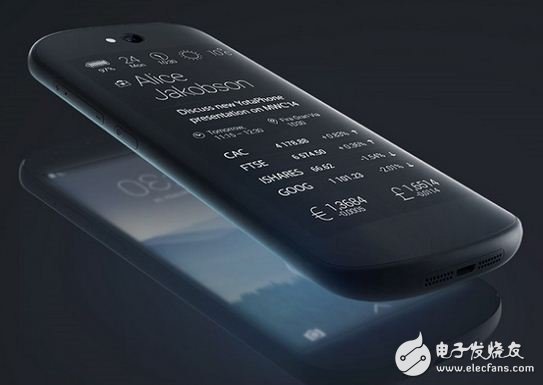
The back of YotaPhone 2 is an electronic ink screen.
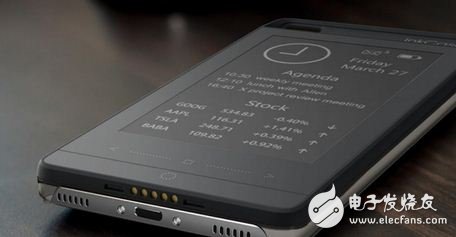
Huawei P8 provides E-Ink electronic ink screen back shell
The origin of electronic ink technology [1]
In the 1970s, Japan first studied electrophoretic display technology. However, the initial electrophoresis was once interrupted due to shortcomings such as short display life, instability, and difficulty in colorization. At the end of the 20th century, American E-Ink Company invented electrophoretic ink (also known as electronic ink) by electrophoresis technology, which greatly promoted the development of this technology. Electronic inks are often made into thin films for use in electronic displays, especially for e-books such as Sony Reader, iLiad, Cybook Gen3, Amazon Kindle, Logic's eReader, and Polymer Vision's Readius devices. In recent years, it has gradually appeared on mobile phones and wearable devices.
Amazon Kindle e-book reader with electronic ink screen
Sony SmartBand Talk with electronic ink screen
The principle of electronic ink screen [2]
The electronic ink screen is made up of many electronic inks, which can be viewed as capsules. There is a liquid charge in each capsule (position 6), where the positive charge is white and the negative charge is black. When we give positive and negative voltages on one side (position 8), the charged liquid will be attracted and repelled separately.
In this way, each pixel can be displayed in white or black.
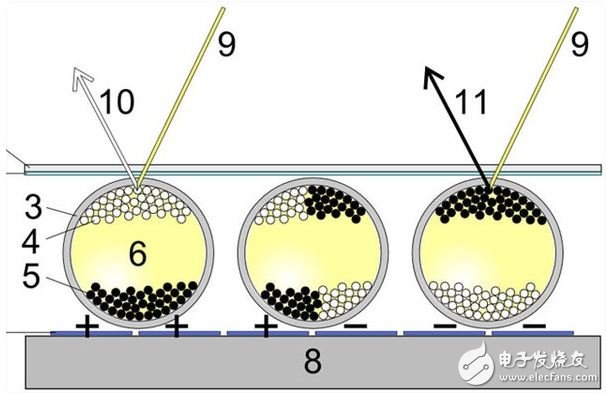
Legend: 1. Surface layer 2. Transparent electrode (ITO) 3. Capsule 4. White pigment with punctuality 5. Black pigment with negative charge 6. Transparent dispersion medium 7. Lower electrode 8. Support layer 9. External light 10. White 11. yellow
Because the refresh of the electronic ink is discontinuous, the current graphics can be maintained every time the refresh is completed, even if the battery is unplugged. Some people may ask, if you pull out the battery to attract the voltage of the electronic ink, then the ball will not return to its original state or enter a random chaotic state?
The answer is because electronic ink has a bistable effect (hysteresis effect). In the figure below, the horizontal axis is the voltage supplied by the device, and the vertical axis is grayscale (assuming it is the whitest and the negative is the darkest). The process of increasing the voltage and the process of decreasing, giving the same voltage, the degree of black and white of the electronic ink is different. This effect is called the bistable effect (hysteresis effect).
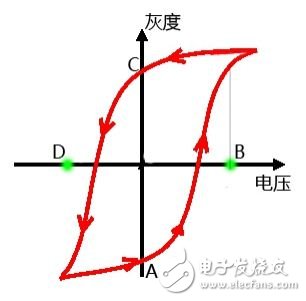
Using this effect, we can give a positive voltage (from 0 to B, go up the route below), attract negative charges, show positive charge white to the reader, then power down (from B to 0, go above That route back)). White is maintained.
Therefore, the electronic ink device saves power because the screen portion consumes zero power if there is no need to change the display.
Note: Do not change the screen device itself without power is due to the standby consumption of the board and the battery's own internal resistance consumption
Note 2: Other common displays No matter the screen content changes, the power consumption of the screen part is continuous, and the change is not big.
Advantages and disadvantages of electronic ink screen
The electronic ink screen has many advantages such as easy-to-read, power-saving, and bendable. The following mainly introduces two aspects of easy-to-readness and power saving.
Reading experience comparable to physical books
We often hear that the electronic ink screen does not hurt the eyes. What is the reason?
First, electronic ink technology relies on reflection rather than emitted light. The display with electronic ink technology reflects light like plain paper, which ensures that the text looks natural under any lighting conditions (not reflective, perfect under strong light).
E-paper display contrasts with LCD:
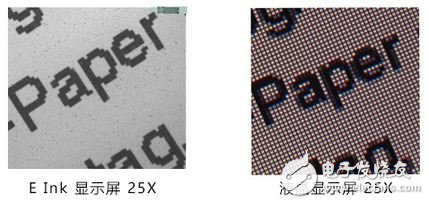
Second, there is no flicker. Traditional LCD screens are flickering because they are constantly refreshing. Although the naked eye may not be noticeable, this phenomenon exists objectively, which is also a major cause of eye strain caused by viewing the screen.
The electronic ink screen is not displayed by constantly refreshing the screen. Once the screen is refreshed, there is no change, so there is no problem that the traditional liquid crystal display "blinks" and hurts the eye.
In addition, the reading angle of the electronic ink screen can be close to 180°. Full-view reading can lead to a better reading experience.
Low power consumption, power saving
The electronic ink screen consumes power only when it is turned over, and does not consume power when the display content is not refreshed. After the content is refreshed, it will stay on the screen for a long time, and the battery can be removed when reading. Therefore, devices using this screen will be very power efficient, like Amazon's Kindle Paperwhite, which lasts up to 8 weeks.
These advantages stem from the innate advantages of the working principle of electronic ink screens. Of course, there are advantages and disadvantages in everything. This working principle also makes it have many application defects.
Very low refresh rate, not enough to display dynamic content
Due to the working principle of the electronic ink screen, the refresh rate is extremely low, and the display of dynamic content cannot be satisfied.
The low refresh rate of the limited electronic ink screen has a significant delay in switching pages. In addition to reading, other applications are very limited. Even the Internet tour is very tasteless, not to mention the video.
Full-screen reverse color refresh is visually unpleasant
Many friends who are planning to buy a Kindle will hesitate because they can't stand the "splash screen" when they turn pages. The visual "splash screen" here refers to the full-screen reverse color refresh of the screen. Why do every change (such as turning pages), or every time you need to have a clearing action? This problem is also caused by the principle of the electronic ink screen itself, let's take a look at the picture just now.
Why do e-ink screens often need full-screen reverse color refresh? [2]

We just assumed that the voltage increases from 0 and then decreases to 0, but the gray level of the electronic ink changes from position A to position C. Then if the next change, if I reduce the voltage, that is, continue to walk along the above return path, there is no problem. But if the next refresh, I still need this pixel to display white, then the route followed by the ink at point C is not the same. The gray level corresponding to the voltage driven by the circuit will be inaccurate. The result is that the black ink is not black in color, and some of the white ink is not completely white. There will be ghosts, or afterimages.
Therefore, in order to avoid the occurrence of afterimages, all of them are added to the maximum or minimum voltage, all the inks are cleared, and the adjustment is started from the initial state, so that all the ink balls can maintain uniform display of only two colors.
What is the future of the color electronic ink screen? [3]
The color electronic ink screen is formed by three electronic inks passing through the RBG filter to form three primary color sub-pixels, and then mixed by light to become one pixel.
As shown in the figure, the three electronic ink particles are a group, and the different colors of the red, green and blue primary colors can be mixed to produce the specific color we need. Such a set of particles is considered to be a pixel (the point on the right side of the figure) as the smallest element of the display.
The biggest difference between this technology and black and white electronic ink is that the brightness is too low. Because now you need 3 to be combined into 1 point, when you need to display it as full red, the brightness is only 33% of 1 pixel. Electronic ink is displayed by means of ambient light. In this way, the brightness of ambient light is more demanding.
We can already see some color electronic ink screen devices, such as Hanwang's e-book, the smart watch Toq released by Qualcomm, and the new generation Pebble just launched this year.
E-Ink's official data shows that its 璀璨 color e-paper display can provide 4096 colors, suitable for a variety of image-rich information applications such as charts, graphics, maps, photos, comics and advertisements. Like E-Ink's black and white e-paper products, the E-Ink 璀璨 color e-paper display provides a paper-like experience with crisp text and fine color graphics, making it completely visible even in direct sunlight, making it ideal for low-cost applications. Portable device for electrical demand.
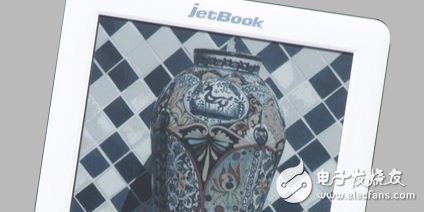
The picture tones look a bit "small and fresh". . . . . .
A new generation of Pebble with color E-Ink screen
Conclusion
Because of the comfortable reading and low power consumption characteristics, coupled with the influence of Kindle, YotaPhone, etc., electronic ink screens have attracted more and more attention from the public. In addition to the applications of e-readers, second screens of mobile phones, and smart watches, what areas do you think electronic ink screens can be used in?
What is a Rigid Flex PCB?
Rigid flex printed circuit boards are boards using a combination of flexible and rigid board technologies in an application. Most rigid flex boards consist of multiple layers of flexible circuit substrates attached to one or more rigid boards externally and/or internally, depending upon the design of the application. The flexible substrates are designed to be in a constant state of flex and are usually formed into the flexed curve during manufacturing or installation.
Rigid flex designs are more challenging than the design of a typical rigid board environment, as these boards are designed in a 3D space, which also offers greater spatial efficiency. By being able to design in three dimensions rigid flex designers can twist, fold and roll the flexible board substrates to achieve their desired shape for the final application's package.
Benefits:
More components in a smaller space
Improved signal quality and integrity
Easy to test
Very reliable in harsh environment
Reduces system costs
Weight reduction
Our expertise – your profit!
The circuit board is no longer thought of as simply something to hold other elements. In fact, it is part of the system and offers a diverse range of options to integrate different functions. We want to support our customers as early on in the development process as possible so that they can get the most out of our wide-ranging expertise. In this way we can succeed in finding the perfect solution for the specific situation whilst keeping an overview of the entire system.
Rigid-Flex PCB,Rounded Rigid-Flex PCB,Green Rigid-Flex PCB,Complex Rigid-Flex PCB
Storm Circuit Technology Ltd , https://www.stormpcb.com